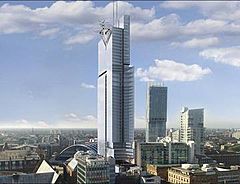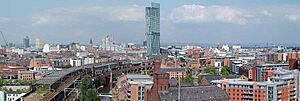Intercontinental Tower, Manchester facts for kids
Quick facts for kids Intercontinental Tower |
|
|---|---|

Artist's render of how the preferred design was to look when constructed
|
|
| General information | |
| Status | Proposed |
| Type | Hotel and residential |
| Location | Windmill Street, Manchester |
| Construction started | Never started |
| Cost | £80 million |
| Management | InterContinental Hotels Group |
| Height | |
| Antenna spire | 200 m (660 ft) max |
| Roof | 160 m (520 ft) est. |
| Technical details | |
| Floor count | 30 to 48 storeys est. |
| Design and construction | |
| Architect | Stephenson Bell |
| Developer | Benmore |
| Other information | |
| Number of rooms | 250 |
The Intercontinental Tower, Manchester was a very tall building planned for Manchester city centre, England. It was going to be a fancy five-star hotel run by InterContinental Hotels Group. A company called Benmore from Northern Ireland was developing it. However, the project was cancelled, so the tower was never built.
This huge skyscraper was first talked about in May 2009. The builders, Benmore, discussed it with the Manchester City Council. In 2010, the city council even included the tower in their early plans. These plans aimed to make the area around it look new and better. Not many people were against building such a tall building in this historic part of the city.
The tower was designed to have a special landing spot for helicopters (a helipad). It would also have two cool decorative spires, like the famous Willis Tower in Chicago. These spires would have made it about 200 meters (656 feet) tall. That's 30 meters (98 feet) taller than the Beetham Tower. The Beetham Tower was Manchester's tallest building at that time. The first plans for this 48-storey tower were made before the Great Recession. But they were stopped when the financial markets crashed. Later, talks started again. Architect Roger Stephenson designed a smaller 25-storey tower. This new design would have 270 hotel rooms and a special 'presidential suite' at the very top. The old theatre's front would have been kept. It would become the entrance to the hotel lobby. The new building was meant to be built behind this old theatre front.
What Was the Plan?
The skyscraper was first suggested in May 2008. It was called the Theatre Royal Tower back then. Its first design was changed, and its height was increased. It went from about 118 meters (387 feet) to 200 meters (656 feet) tall.
The developers, Benmore, had invested in Manchester before. In 2010, they announced they were in "advanced negotiations." This meant they were close to bringing a famous hotel chain to the city. This hotel would be the first of its kind in the North West of England. InterContinental Hotels Group was thought to be this hotel chain. One reason for the tower's location was its closeness to the Manchester Central Conference Centre. This centre is a popular place for business and political meetings. The tower would have been inside the security area for the conference centre.
The tower would have been close enough to the Beetham Tower. This would make them look like a group of tall buildings together. A helipad was also planned for the top of the skyscraper. This would have been the first of its kind in the United Kingdom.
Concerns and Discussions
In October 2009, the manager of Manchester's Radisson Blu Edwardian Hotel shared his thoughts. He believed the city had enough hotels. He thought there would be no big new hotel projects for three years. Manchester City Council held a public meeting about the plans in February 2010. The Radisson Edwardian hotel said they had "no objection" to fixing up the old theatre. However, they strongly disagreed with building a "tall" building there. They defined "tall" as any building over 15 storeys.
The council agreed that a "new quality hotel" was being planned. But they said that building a taller building on this site was already accepted. This was because permission was given for a 17-storey office building in 2005. The council believed that a building of that height was fine for the historic area. So, they did not think the new building at the Theatre Royal site should be limited to 15 storeys. The plan was to build the skyscraper behind the Theatre Royal. The theatre itself would have been restored and saved for the future.
Images for kids



